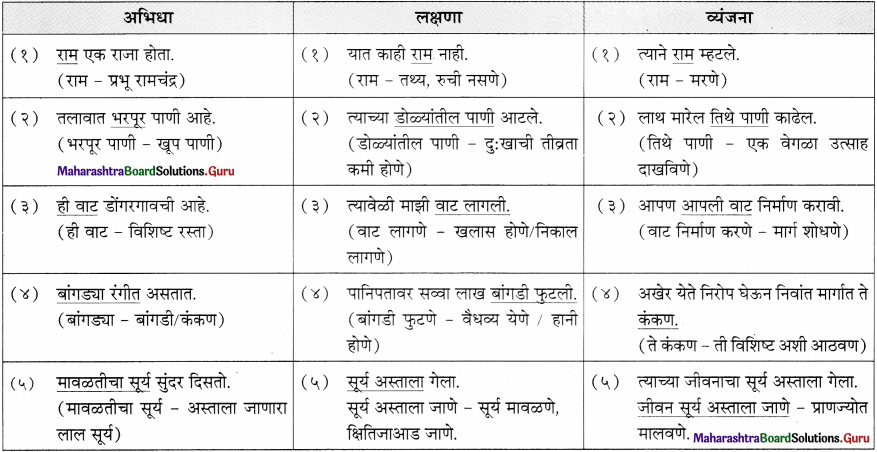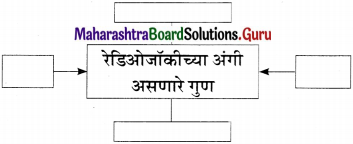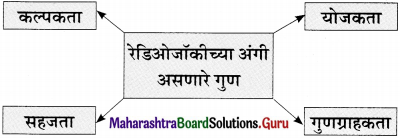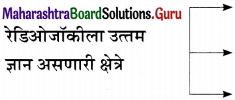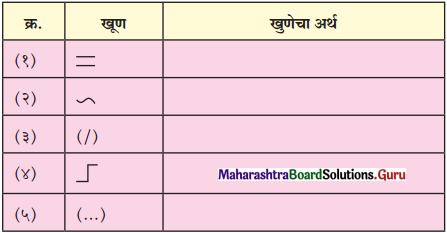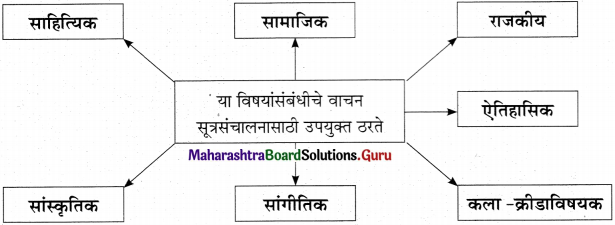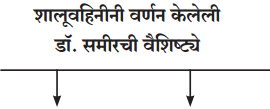11th Marathi Bhag 5.1 Exercise Question Answer Maharashtra Board
Balbharti Maharashtra State Board Marathi Yuvakbharati 11th Digest Bhag 5.1 व्याकरण शब्दशक्ती Notes, Textbook Exercise Important Questions and Answers.
व्याकरण शब्दशक्ती 11 वी मराठी स्वाध्याय प्रश्नांची उत्तरे
11th Marathi Digest Chapter 5.1 व्याकरण शब्दशक्ती Textbook Questions and Answers
कृती
प्रश्न 1.
सूचनेनुसार सोडवा.
‘मी वि. स. खांडेकर’ वाचले. या वाक्यातील लक्ष्यार्थ लिहा.
(अ) मी वि. स. खांडेकर यांना पाहिले.
(आ) मी वि. स. खांडेकर यांच्याशी बोललो.
(इ) मी वि. स. खांडेकर यांचे साहित्य वाचले.
उत्तरः
(इ) मी वि. स. खांडेकर यांचे साहित्य वाचले.
![]()
प्रश्न 2.
मूळ शब्दशक्ती …………………………….. आहेत.
(अ) एक
(आ) चार
(इ) तीन
उत्तरः
(इ) तीन
प्रश्न 3.
“निवडणुका आल्या, की कावळ्यांची कावकाव सुरू होते.’ या वाक्यातील शब्दशक्ती लिहा.
(अ) अभिधा
(आ) लक्षणा
(इ) व्यंजना
उत्तरः
(इ) व्यंजना
प्रश्न 4.
‘आपल्याभोवती वावरणाऱ्या कोल्ह्यांपासून दूरच राहावे.’ या वाक्यातील कोल्हा’ या शब्दातून व्यक्त होणारा लक्ष्यार्थ….
(अ) जंगलातील धूर्त प्राणी
(आ) मळ्यातील मका खाणारा
(इ) धूर्त माणसे
उत्तरः
(अ) जंगलातील धूर्त प्राणी
प्रश्न 5.
‘घरावरून मिरवणूक गेली.’ या वाक्यातील शब्दशक्ती लिहा.
(अ) अभिधा
(आ) लक्षणा
(इ) व्यंजना
उत्तरः
(आ) लक्षणा
![]()
प्रश्न 6.
‘मी एक लांडगा पाहिला.’ या वाक्यातील शब्दशक्ती लिहा.
(अ) व्यंजना
(आ) अभिधा
(इ) लक्षणा
उत्तरः
(आ) अभिधा
प्रश्न 7.
‘समाजातील असले साप ठेचलेच पाहिजेत.’ या वाक्यातील शब्दशक्ती लिहा.
(अ) लक्षणा
(आ) व्यंजना
(इ) अभिधा
उत्तरः
(आ) व्यंजना
प्रश्न 8.
खालील तक्ते पूर्ण करा.
(अ) शब्दशक्ती ओळखा.

उत्तरः

![]()
(आ) शब्दशक्तीनुसार शब्द व वाक्य लिहा.

उत्तरः

(इ) शब्दशक्तीनुसार तक्ता पूर्ण करा.

उत्तरः

![]()
11th Marathi Book Answers Chapter 5.1 व्याकरण शब्दशक्ती Additional Important Questions and Answers
सूचनेनुसार कृती करा.
प्रश्न 1.
‘घड्याळाने पाचचे ठोके दिले.’ या वाक्यातील शब्दशक्ती ओळखा.
पर्याय :
(अ) अभिधा
(आ) व्यंजना
(इ) लक्षणा
उत्तर:
(अ) अभिधा
प्रश्न 2.
आम्ही बाजरी खातो’ या वाक्यातून शब्दशक्तीचा हा अर्थ समजतो.
पर्याय :
(अ) वाच्यार्थ
(आ) लक्ष्यार्थ
(इ) व्यंगार्थ
उत्तर:
(आ) लक्ष्यार्थ
प्रश्न 3.
समाजमान्य अर्थ व्यक्त करणाऱ्या शक्तीस म्हणतात.
पर्याय :
(अ) लक्षणा
(आ) व्यंजना
(इ) अभिधा
उत्तर:
(इ) अभिधा
![]()
प्रश्न 4.
‘आम्ही सगळे भारतीय आहोत.’ या वाक्यातील शब्दशक्ती ओळखा.
पर्याय :
(अ) व्यंजना
(आ) लक्षणा
(इ) अभिधा
उत्तर:
(इ) अभिधा
प्रश्न 5.
‘संप म्हणजे सामान्यांचे मरणच!’ या वाक्यातील शब्दशक्ती ओळखा.
पर्याय :
(अ) अभिधा
(आ) लक्षणा
(इ) व्यंजना
उत्तर:
(आ) लक्षणा
शब्दशक्ती प्रास्ताविकः
आपल्या मनातील विचार, भावना, कल्पना आपण भाषेतील शब्दांच्या माध्यमातून इतरांपर्यंत प्रभावीपणे पोहोचवत असतो. समाज जीवनात वावरताना माणसांचे परस्परांमधील व्यवहार भाषेच्या माध्यमातून सुलभपणे चालत असतात. भाषेच्या माध्यमातूनच साहित्याची निर्मिती होत असते. प्रतिभावंत लेखक-लेखिका, कवी-कवयित्रींकडून वैशिष्ट्यपूर्ण असे भाषिक आविष्कार निर्माण होत असतात.
श्रवण, वाचन, भाषण आणि लेखन ही महत्त्वाची भाषिक कौशल्ये आहेत. बोलण्याची तयारी ऐकण्यापासून होत असते. वाचनाने व्यक्तिमत्त्व बहुश्रुत होते. आपल्या बोलण्याला रंग, रूप, गुण, उंची, खोली असली की आपल्या मनातील आशय इतरांपर्यंत नेमकेपणाने आणि प्रभावीपणे पोहोचवता येतो. मनातील अमूर्त विचार शब्दांद्वारेच मूर्त होत असतात. म्हणूनच माऊली म्हणतात त्याप्रमाणे,
“बिंब जरी बचके एवढे। परी प्रकाशाशी त्रिभुवन थोकडे।
शब्दांची व्याप्ती येणे पाडे। अनुभवावी।।” आपले शब्द हे आपल्या समग्र व्यक्तिमत्त्वाचा हुंकार असतो. प्रसंगानुसार शब्दयोजना व आशयानुसार केलेली अभिव्यक्ती श्रोत्यांना व वाचकांना आपल्या कवेत घेते.
शब्दशक्ती
शब्दांच्या अंगी शब्दाच्या मूळ अर्थाव्यतिरिक्त वेगळा असा अर्थ संदर्भाने प्रकट करण्याचे विशिष्ट प्रकारचे सामर्थ्य असते. शब्दांच्या या सामर्थ्यालाच शब्दशक्ती असे म्हणतात.
उदा.
- मी आज मोठा दगड पाहिला.
- त्याचे बोलणे म्हणजे काळ्या दगडावरची रेघ.
- माझ्या मना बन दगड.
पहिल्या वाक्यात ‘दगड’चा अर्थ पाषाण/धोंडा असा आहे. दुसऱ्या वाक्यात काळा दगड चा अर्थ पक्का/कधीही न बदलणारा/ठाम असा आहे. तिसऱ्या वाक्यात दगड चा अर्थ कठोर अंत:करण करणे असा आहे.
![]()
शब्दांच्या अंगची ही शक्ती तीन प्रकारची आहे.
शब्दशक्ती :
- अभिधा
- लक्षणा
- व्यंजना
| अभिधा | लक्षणा | व्यंजना |
| (१) शब्द वाचल्याबरोबर त्याचा शब्दश: अर्थ समजतो. | (१) शब्दाचा मूळ अर्थ उपयोगी पडत नाही म्हणून संदर्भानुसार दुसराच अर्थ घ्यावा लागतो. | (१) शब्दाच्या मूळ अर्थाशी सुसंगत असा वेगळाच अर्थ सूचित होतो. |
| (२) अभिधा शक्तीच्या साहाय्याने प्रकट होणाऱ्या अर्थाला ‘वाच्यार्थ’ म्हणतात. | (२) लक्षणा शक्तीच्या साहाय्याने प्रकट होणाऱ्या अर्थास ‘लक्ष्यार्थ’ म्हणतात. | (२) व्यंजना शक्तीच्या साहाय्याने प्रकट होणाऱ्या अर्थास ‘व्यंगार्थ’ म्हणतात. |
| (३) रूढ, समाजमान्य व शब्दकोशात हा अर्थ दिलेला असतो. | (३) संदर्भानुसार दुसराच अर्थ घ्यावा लागतो. मूळ अर्थ दुसऱ्या अर्थाला लक्षितो. | (३) मूळ अर्थाशी सुसंगत असा वेगळाच अर्थ घ्यावा लागतो. |
| (४) शब्दाचा मूळ अर्थ | (४) शब्दाच्या मूळ अर्थास बहुतेक वेळा बाधा येते. | (४) मूळ अर्थाला बाधा न येता दुसराच सुसंगत असा अर्थ. |
| उदा. 1. काल मला रानात साप दिसला. (साप सर्प / नाग) 2. नानां काल पर्वतीवर गेले. (काल म्हणजे कालच) अभिधा शक्तीत साधा, सरळ अर्थ समजतो. | उदा. 1. घरावरून साप गेला.(घरावरून घरासमोरून, घराजवळून) 2. नाना काल पर्वतीवर गेले. (पर्वतीवर मृत्यू पावले) लक्षणा शक्तीत हे कसे शक्य आहे? म्हणून दुसराच अर्थ घ्यावा लागतो. | उदा. 1. समाजातील असले साप ठेचलेच पाहिजेत. (साप दुष्ट/वाईट/लबाड व्यक्ती) 2. नाना काल पर्वतीवर गेले. (पर्वतीचा डोंगर चढून गेले) व्यंजना शक्तीचा वापर दुसऱ्याला नावे ठेवण्यासाठी केला जातो. |
![]()
व्यंगार्थाची गंमत :
व्यंजना या शब्दशक्तीने व्यंगार्थ समजतो.
उदा. सूर्य उगवला – म्हणजेच सूर्योदय झाला. परंतु व्यक्तिगणिक याचा अर्थ वेगवेगळा सूचित होतो.
| वाक्य | व्यक्ती | व्यक्तींच्या दृष्टीने अर्थ |
| सूर्योदय झाला. | घरातील काही व्यक्ती | झोपेतून उठण्याची वेळ झाली. |
| घरातील गृहिणी | झाडलोट व सडापाणी करण्याची वेळ झाली. | |
| घरातील आजी – आजोबा | प्रातः प्रार्थनेची वेळ झाली. | |
| शाळेत जाणारे विदयार्थी | मुला – मुलींची आंघोळीची वेळ झाली. |
शब्दशक्तींची गरज :
साहित्यिकांना ललित वाङ्मयात आपल्या जीवनानुभवांचे दर्शन इतरांना प्रभावीपणे घडविण्यासाठी, शब्दांच्या पलिकडचा भाव व्यक्त करण्यासाठी, मूळ भावार्थाशी संलग्न अर्थच्छटांना दर्शविण्यासाठी, काव्यात व्यंगामुळे सूचकता व अधिक परिणामकारकता निर्माण करण्यासाठी शब्दशक्तीच्या माहितीची आवश्यकता आहे.
